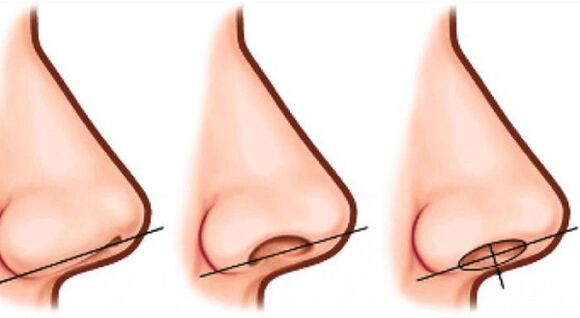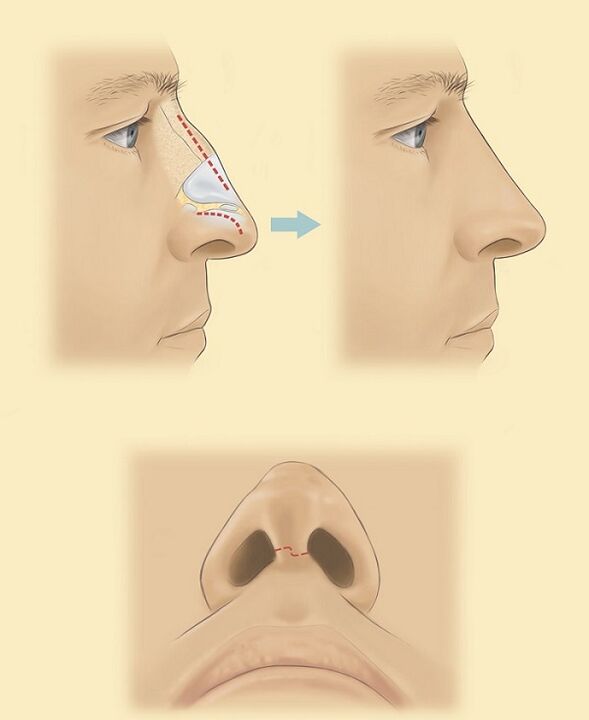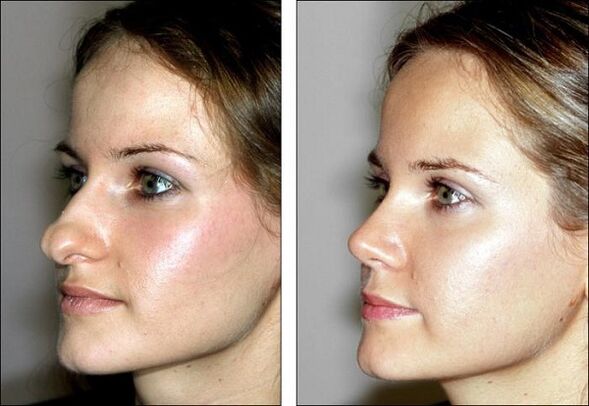More and more people are dissatisfied with their appearance and are trying to somehow correct some parts of the body. Sometimes it's crazy, but to a greater extent, everyone has started to treat it completely indifferently, as the demand for plastic surgery is growing every year. For example, rhinoplasty is an opportunity to correct the shape of your nose, while blepharoplasty corrects the eyelids, etc.

What is rhinoplasty
Rhinoplasty is an operation that changes the shape and, if desired, the size of the nose. The first such correction was made by a German surgeon named Jacques Jozev in the first half of the last century. After this successful experience, this type of surgery began to gain popularity every day and thanks to the constant development of medicine and equipment it has become even easier and safer. The very essence of this surgery is to change the bone and cartilage frame of the nose as soon as the skin is removed. Despite the fact that this type of procedure is already very popular, there are still quite a number of myths that in one way or another can scare the patient.
Myths and reality
The first myth says that this type of surgery can be performed by any plastic surgeon. In fact, the doctor of this specialization must be able to have at least knowledge and at most superficial skills. Unfortunately, this does not mean that he has enough practical experience to perform such an operation at the highest level. This procedure is very complicated and every plastic surgeon must know all the nuances and subtleties of the structure of the nose and respiratory system, as the main task is not only the attractiveness of the patient, but also the proper functioning of the body after surgery. In this case, the doctor must observe the aesthetic proportions of the face.
It is believed that rhinoplasty of the nose is performed mainly for those people who have some obsession with remodeling their bodies. But the fact is that the doctor himself may prescribe such a correction if the proper functioning of the respiratory system is impaired. At the same time, there is no denying the fact that a beautiful and graceful nose gives more self-confidence (especially for women), which will definitely change lives for the better. But to view this operation as satisfying the inner "ego" is completely wrong, rather as a modern type of psychotherapy.
Rumors that nasal rhinoplasty is a painful operation are not unfounded. Like any other surgery, it carries some risks, but compared to the same breast augmentation, the first is less dangerous. As for the pain, the patient will not feel it, as the whole procedure is performed under general anesthesia. After the operation, the swelling and slight discomfort last 5-7 days, but no more.
Some people think that rhinoplasty is better in spring or summer, but in fact this is a pure myth, as the procedure can be performed at any time of the year.
The best rhinoplasty is the one performed by a professional doctor, after which there will be no traces of the intervention. Whether the operation will be noticeable or not depends initially on the degree of curvature.
Do not think that rhinoplasty can completely change the shape of the nose so that it becomes perfect. It is very limited by the individual characteristics of the structure, the skin and the cartilaginous framework, due to which patients may even be dissatisfied with the result of the operation. So, according to statistics, every tenth patient, after the tissue has healed, returns to the doctor to change its shape.

Choosing a new nose
In order to take into account the capabilities of the doctor and the requirements of the patient, a computer diagnosis is made, after which you will be provided with a photo. Rhinoplasty and, accordingly, the surgeon himself cannot exceed the safe intervention if the shape of the nose does not allow to obtain the desired result. But the doctor will be able to suggest an intervention that is as close as possible to the ideal.
Based on the aesthetics of the parameters of the nose, more attention is paid to the angle of the profile, which is calculated by the line connecting the chin to the forehead relative to the back of the nose. As for women, rhinoplasty at the tip of the nose is important to them when it is done slightly raised above the plane. Thanks to this correction, the face becomes noticeably younger. Remember that the shape will be chosen by the surgeon, taking into account the parameters of the face as much as possible. The operation should be performed in such a way that the nose is not only in harmony with the rest of the body, but also gives individuality to the owner.
Types of rhinoplasty
Rhinoplasty is a surgical procedure that is represented by several types:
- open intervention;
- surgery without skin removal (closed);
- use of fillers;
- repeated (secondary);
- columella surgery;
- change in the shape of the nostrils;
- rhinoplasty of a wide nose.
As for the first method, the doctor makes an incision directly on the bridge between the nostrils, thus achieving the maximum possible view for the surgeon. In this case, full control over the course of the operation is possible. During the closed method, the incision is made from the inside, which makes it less traumatic, just as when correcting the shape of the nose, thanks to the use of fillers. Other types of interventions are determined based on individual anatomy.

Rejuvenating rhinoplasty
Recently, the most popular type of rhinoplasty is a procedure in which an adjustment is made to affect the age-related increase in the swelling of the nasal spine, sagging of the tip and base. Over time, it becomes larger and more visible, which makes a woman look older. In addition, with age, the ears also increase, so the surgeon must take this into account when adjusting so that everything is proportional. Even with a facelift, it is often necessary to adjust the nose to the new contour of the face. By the way, anti-aging rhinoplasty is the most individual type. The prices for this type of adjustment will also be different in each case.
Contraindications
There is a certain list of conditions under which the operation is not performed:
- Rhinoplasty is not performed under the age of 18 unless a post-injury measure is needed.
- Inflammatory processes of the skin in the nose.
- Serious diseases of the internal organs that can cause complications.
- Infectious, oncological and acute viral diseases.
- Diabetes.
- Blood diseases.
Preparation for surgery
High-quality rhinoplasty is above all a complete understanding between the doctor and the patient. During the first appointment, the surgeon must listen to all wishes. In addition, based on the requirements, the physician should discuss possible techniques that will be relevant in a given case. Then there is an assessment of various nuances that may directly or indirectly affect the course of the operation. The choice of a particular technique is based only on the following parameters:
- Customer requirements;
- the structure of the osteochondral corset of the nose;
- skin condition and thickness;
- the patient's age;
- face type.
At the same stage it is necessary to perform computer modeling, the purpose of which is the virtual creation of the shape of the nose with the help of a special program. With regard to the choice of surgical technique, the initiative is transferred entirely into the hands of the surgeon. An in-depth story is taken.
The doctor must inform his patient about the proper preparation for the operation. This includes eliminating certain foods from the diet, mandatory smoking cessation and limiting the intake of certain fluids, especially alcohol.
Surgery may be delayed if the patient has recently had a skin infection or upper respiratory illness. Approximately 1-2 weeks before the correction procedure, it is necessary to completely give up drugs that contain salicylates.
Operation
There are currently a sufficient number of private and public clinics where rhinoplasty can be performed. The prices in such medical establishments are determined depending on the level of the institution, the equipment, the professionalism of the doctors and, of course, the procedure they offer and carry out. Local anesthesia is often used and several sedative cubes are injected into the vein. There are times when general anesthesia is required. Throughout the operation, the patient is under constant monitoring of special computer equipment that monitors the stable operation of the heart, pulse, pressure.

At the end of all surgical interventions and procedures, the patient is transferred to the ward. There can often be some discomfort, but everything disappears quickly with appropriate targeted medications. In some types of operations it is necessary to apply a special splint so that the nose is stationary and protected from accidental bruises. If rhinoplasty is performed on the tip of the nose, then a special triangular bandage is applied for support, it is possible to use nostril splints, which are placed inside. It is possible to leave the clinic within a few hours, but some patients choose to stay overnight.
Execution
The operation itself does not take very long, about a few hours, it all depends on the chosen method of intervention and the initial complexity.
The first stage involves cutting the vestibule of the nasal mucosa. The surgeon is then required to adjust the tip of the nose, sometimes it is necessary to change the height of the nostrils and the width of the base of the nose. After removing the hump or nose, the necessary appearance is given, the final correction is made with the help of cartilage and they can be their own or preserved. During deformities, the operation proceeds in parallel with the change in the position of the nasal septum.
It is worth noting that after all the manipulations performed, the nose undergoes some changes that the surgeon cannot predict with 100% accuracy, this can be proven by numerous photos. Rhinoplasty is a very complex procedure, but there is still a small percentage of failed interventions that are due solely to the individual characteristics of the patient.

Possible complications
Every surgical intervention in the body is not natural and does not pass without leaving a trace, and rhinoplasty is no exception. Surgeons, of course, must have a high level of qualification, but sometimes there can be complications that are related exclusively to individual characteristics. They include:
- anatomical structure;
- anesthesia reaction;
- wound healing;
- nosebleeds;
- the general reaction of the body to surgery;
- infection.
The risk of complications can be reduced to zero if you carefully follow all the doctor's recommendations.

Recovery
In the first days after rhinoplasty, the nose can cause some discomfort. There is also the appearance of puffiness around the eyes, but after 4 days after the operation there will be no trace of them. After 2 weeks, the nose will almost completely fix its final shape, but still the full formation occurs within six months. During this period, you need to be especially careful when caring for the skin in the nasal area, because it will become particularly susceptible to damage. During this period, it is recommended to refuse to visit the sauna and wear glasses for a month and a half.

Return to normal life
If you do not work hard, then you can start your daily life or even work within 1 week after the operation. As for the resumption of sports, it is recommended to start them no earlier than 3-4 weeks. You should also avoid direct sunlight on your face. In fact, anyone can have a rhinoplasty, but it will be possible to obtain and consolidate the desired result only in full compliance with all the recommendations of the doctor.




















